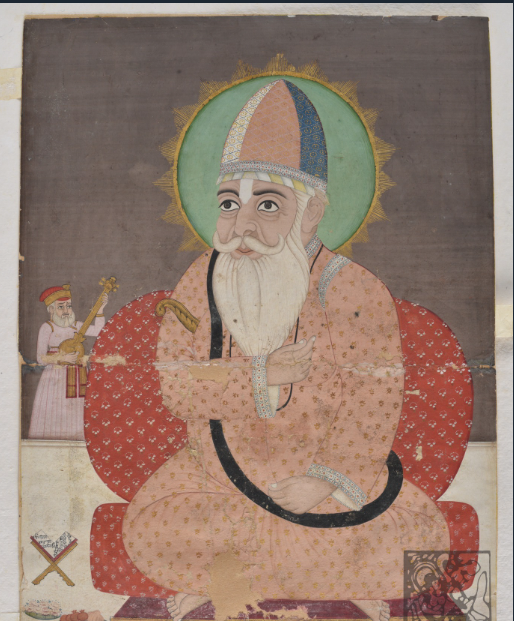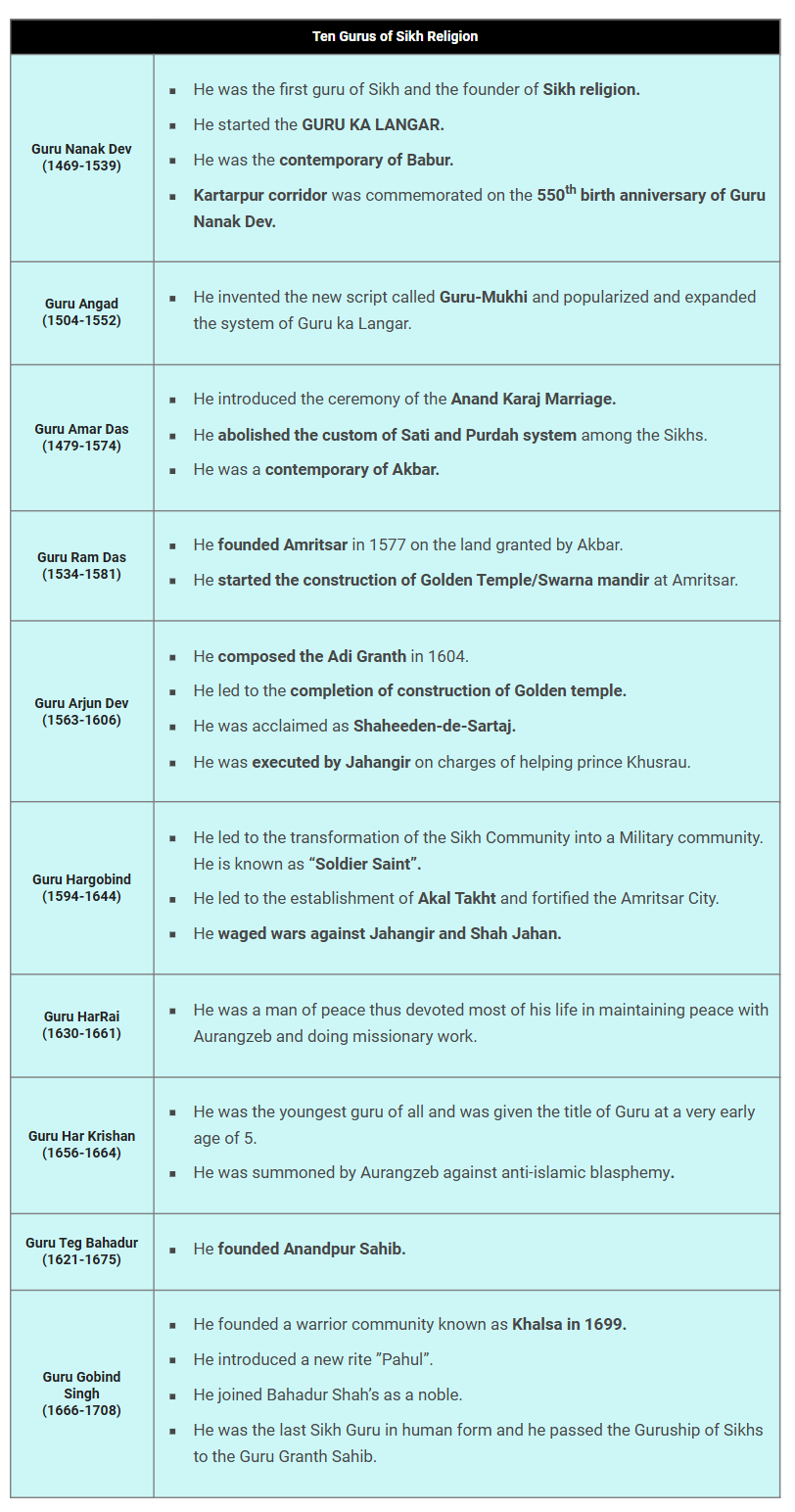Guru Nanak Jayanti 2025: Celebrating the Birth of the Founder of Sikhism | 05 Nov 2025
For Prelims: Guru Nanak Dev, Sikhism, Sikh Takhts, Khalsa, Panj Pyare
For Mains: Ancient Indian History, Guru Nanak Dev and his teachings, Sikhism
Why in News?
Guru Nanak Jayanti, also known as Gurpurab, is celebrated on 5th November 2025, marking the 556th birth anniversary of Guru Nanak Dev (1469–1539). The day commemorates the founder of Sikhism, celebrating his message of equality, and compassion.
Guru Nanak Jayanti
- It is celebrated on the day of Kartik Poornima, which is the fifteenth lunar day in the month of Kartik according to the Hindu calendar, and usually falls in the month of November by the Gregorian calendar.
- A day before Gurpurab, devotees take part in Nagar Kirtan processions led by the Panj Pyare carrying the triangular Sikh flag, the Nishan Sahib, with the Guru Granth Sahib placed in a palanquin, accompanied by hymn singing and Gatka martial arts displays.
- On Guru Nanak Jayanti, processions are followed by Langar at Gurdwaras, where volunteers serve free meals to all.
- Langar, from a Persian word for “almshouse,” is the Sikh community kitchen that feeds anyone reflecting equality and service.
Who was Guru Nanak Dev Ji?
- About: Guru Nanak Dev Ji was born in 1469 at Talwandi (now Nankana Sahib, Pakistan) and attained spiritual enlightenment in 1496 at Sultanpur Lodhi.
- As the founder of Sikhism and the first of the ten Sikh Gurus, he rejected caste discrimination, ritualism, and idol worship, advocating devotion to one formless God.
- He passed away in 1539, after appointing Guru Angad as his successor.
- Key Teachings of Guru Nanak Dev Ji:
- Oneness of God (Ik Onkar): He taught that there is only one, formless, eternal God who is present in all beings.
- True worship lies in remembering God with sincerity rather than rituals.
- Equality of All Humans: He rejected caste, untouchability, and religious hierarchy. All people, regardless of identity, share the same divine light.
- Three Pillars of Sikhism: Guru Nanak formalised the three pillars of Sikhism (Naam Japna, Kirat Karna, and Vand Chhakna) to promote righteous living, dignity of labour, and social equality.
- Naam Japna: Devote constant remembrance of God’s name to overcome the five evils (lust, anger, greed, attachment, and ego).
- Kirat Karna: Work hard and earn a livelihood through honest, ethical means to avoid exploitation and deceit.
- Vand Chhakna: Share what you have with those in need. Wealth is God’s gift and must be used for the welfare of society.
- Sarbat da Bhala (Welfare of All): He thought to pray for the wellbeing of everyone, regardless of religion, caste, gender, or background.
- Oneness of God (Ik Onkar): He taught that there is only one, formless, eternal God who is present in all beings.
What is Sikhism?
- About: It is a monotheistic religion founded by Guru Nanak Dev Ji in the 15th century in Punjab.
- The word Sikh means disciple, reflecting a life guided by teachings of the Sikh Gurus.
- It grew through the teachings of ten Gurus and was shaped by the Bhakti and Sufi traditions.
- Sikhism focuses on devotion to one God, ethical living, and equality.
- Khalsa: It comprises Sikhs who undergo the baptism ceremony, follow the Sikh code of conduct, and wear the Five Ks (Kesh (uncut hair), Kangha (wooden comb), Kara (iron bracelet), Kachera (cotton undergarment), and Kirpan (ceremonial dagger)).
- Sacred Texts: The Guru Granth Sahib, written in Gurmukhi script, is the eternal Sikh scripture containing hymns of Sikh Gurus and saints.
- The Dasam Granth, linked to Guru Gobind Singh, is considered a supplementary text.
- Institutions of Sikhism:
- Gurdwara The Sikh place of worship, open to all regardless of caste, gender, or religion. It serves as a centre for prayer, community service, and learning.
- Takhts (Seats of Authority): The five Sikh Takhts guide religious and temporal affairs, with the Akal Takht in Amritsar being the highest seat of authority.
- The others include Takht Sri Keshgarh Sahib (Himachal Pradesh), linked to the founding of the Khalsa.
- Takht Sri Patna Sahib (Bihar), the birthplace of Guru Gobind Singh.
- Takht Sachkhand Hazur Sahib (Maharashtra), where Guru Gobind Singh was cremated.
- Takht Sri Damdama Sahib (Punjab), where he finalized the Guru Granth Sahib.
- Shiromani Gurdwara Parbandhak Committee (SGPC): Apex elected body managing major Gurdwaras and Sikh religious affairs, headquartered in Amritsar.
- Khalsa Panth: It is the collective body of the Sikh community, the institutional fraternity that represents and manages Sikh religious affairs.
- Gurudwara Reform Movement: The Gurdwara Reform (Akali) Movement began in 1920 to free Sikh shrines from corrupt, British-backed mahants.
- It led to the creation of the SGPC in 1920 and culminated in the Sikh Gurdwaras Act, 1925, granting Sikhs legal control over their Gurdwaras.
How did Guru Nanak’s Teachings Contribute to Societal Transformation?
- Social Equality & Inclusion: Guru Nanak challenged caste discrimination and asserted that dignity belongs to every individual. This helped weaken rigid social hierarchies.
- Women’s Empowerment: He was a strong advocate for gender equality and raised his voice against discrimination against women.
- Institutional Reforms: Guru Nanak strengthened social equality through key institutions.
- Langar offered a free community kitchen where everyone could eat without discrimination.
- Pangat encouraged people to sit together and share meals as equals.
- Sangat brought people together for shared learning, spiritual growth, and collective decision-making.
- Ethical Socio-Economic Order: He encouraged honesty in work and fair distribution of wealth through dasvandh (donating a tenth of one’s income). This promoted dignity of labour and reduced exploitation.
- Interfaith Dialogue & Harmony: Guru Nanak travelled widely across India and beyond, engaging with Hindus, Muslims, Sufis, Yogis, and others, promoting peaceful coexistence.
- Cultural & Spiritual Integration: His teachings blended elements of Bhakti and Sufi movements, promoting spirituality rooted in love, truth, and humanity.
Conclusion
Guru Nanak Jayanti honours Guru Nanak Dev Ji’s teachings of one God, equality, and honest living. His message of service and dignity for all remains deeply relevant. The day encourages people to build a just, compassionate, and inclusive society.
|
Drishti Mains Question: Q. Discuss the continuing relevance of Guru Nanak’s “Ik Onkar” and “Sarbat da Bhala” in addressing communal harmony and social justice in India |
Frequently Asked Questions (FAQs)
1. What are the Three Pillars of Sikhism formalised by Guru Nanak?
Naam Japna (remember God), Kirat Karna (earn honestly), Vand Chhakna (share with others).
2. Which practices institutionalise equality in Sikhism?
Langar (free community kitchen), Pangat (eating together as equals), Sangat (collective congregation).
3. What was the outcome of the Gurdwara Reform (Akali) Movement?
Creation of Shiromani Gurdwara Parbandhak Committee (SGPC) (1920) and passage of the Sikh Gurdwaras Act, 1925, granting community control over Gurdwaras
UPSC Civil Services Examination, Previous Year Questions (PYQs)
Prelims
Q. Consider the following Bhakti Saints: (2013)
- Dadu Dayal
- Guru Nanak
- Tyagaraja
Who among the above was/were preaching when the Lodi dynasty fell and Babur took over?
(a) 1 and 3
(b) 2 only
(c) 2 and 3
(d) 1 and 2
Ans: (b)


